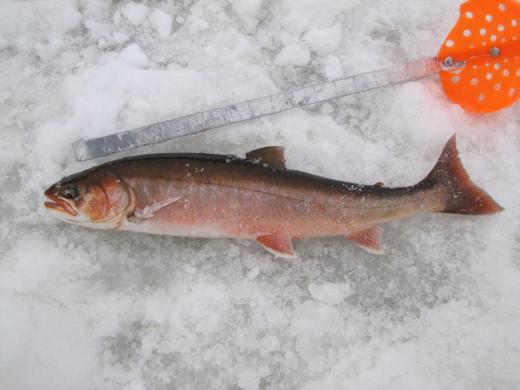By Dave Atcheson
“I cast out and try to be patient, waiting for my fly to sink. On my first cast I’m too patient and snag. On the next I begin my retrieve earlier, an excruciatingly slow retrieve, just a twitch of the line here and there to keep my fly undulating above the weed beds. It’s not long this time before a sharp tug interrupts me, my line snaps to attention, and a beautiful Dolly Varden breaks the calm surface of the lake not 10 feet away. And this one, for the lakes is big—one of those rare 20-inchers, dressed to the nines in its spawning regalia, pirouetting wildly around the canoe…”
This is an excerpt from an early article I wrote on lake fishing in the Swan Lakes/Swanson River recreation area near Sterling, Alaska. Since then, my friend, retired U.S. Fish and Wildlife biologist Jack Dean, has castigated me many times for misidentifying Arctic char as Dolly Varden.
While it may be common for me to plead ignorance, in this case I might have good reason. Likely separated by an ancient common ancestor, these closely related look-alikes have even been mistaken, time and again, by fisheries biologists. Dean sites as an example the longstanding misidentification of anadromous fish in northwestern Alaska as Arctic char, only to later be reclassified as “Northern Dolly Varden.” And here, in Southcentral Alaska, the tendency has been for biologists to call all char except lake trout, Dolly Varden. It’s no wonder we regular fishers are confused.
Whether Dolly Varden, arctic char, or lake trout, these subspecies are all part of the genus called char. We all know, however, that they are different fish. Worldwide, and in Alaska, Arctic char populations stretch farther north than any other freshwater fish. Dean, who has likely done more local research on these fish than anyone, tells me that they very seldom overlap with populations of Dollies and that any char caught within the Swanson River drainage, near my home in Sterling, is likely an Arctic char. “The chances,” he says, “are at least 50 to one that this is the case.”

In his studies Dean has documented two main color phases, along with a “dwarf” Arctic char he found in Cooper Lake. He has also seen occasional anomalies in color, finding what he calls a “yellow mystery fish,” which in addition to its unique color also had decidedly different fins and spots than other char he has encountered.
More practical knowledge for sport fishers, especially those of us who enjoy seeing different fish and adding them to the list of species we’ve caught, is that these fish prefer cold water. Fifty-five degrees or colder, Dean informs me. That makes them easier to catch early or late in the season. During midsummer, lake anglers will want to get deep, 25 feet or more, requiring a lot of weight even for spincasters and a heavy sinking line and weighted flies for fly fishers. Their preferred foods, says Dean, include snails, sticklebacks and sculpins.
Our local Arctic char do not reach particularly large size. The largest taken in studies tipped the scales at just over 4.5 pounds, with most averaging about a pound. Matanuska-Susitna Valley lakes, on the other hand, see Arctic char of much more substantial size, with the largest exceeding 12 pounds.
Arctic char are difficult to differentiate from Dollies, with practice, Dean maintains, it can be done. Arctic char, he explains, have fewer but larger spots, a moderately forked tail, and a narrow caudal peduncle, which for the nonscientists among us is the narrow area between the fish’s tail and body.
It’s easy to see Dean’s great love for the outdoors and his appreciation of these fish, which he calls “the canary in the coal mine.” They are often the first populations to succumb to predation from introduced species or to show the effects of climate change. That’s why, he contends, it’s so important for us to continue studying them. “There’s so much we don’t know,” he says, a childlike enthusiasm and wonder suddenly overcoming his weathered face. “We need someone young to come in and take over these studies. There’s just so much we still don’t know.”
Dave Atcheson is the author of the guidebook Fishing Alaska’s Kenai Peninsula, and National Geographic’s Hidden Alaska, Bristol Bay and Beyond. His latest book, Dead Reckoning, Navigating a Life on the Last Frontier, Courting Tragedy on its High Seas is now available in paperback, online, and as an audiobook. For more info: www.daveatcheson.com.



